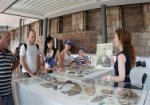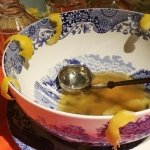For many of us, rum, or brandy perhaps, is the (bottled) spirit of Christmas! And Christmas isn’t Christmas at our place without Rum balls (recipe below). But a couple of hundred years ago in this colony, rum was universal. Our guest blogger this week is Fiona Starr, curator of Hyde Park Barracks and The Mint.
The rum-soaked colony
For the first few decades, the colony was awash with rum. Indeed, it was a deal to import 45,000 gallons of rum and other spirits that financed the construction of Australia’s first permanent hospital, between 1811 and 1816. The southern wing of this ‘Rum Hospital’ is now known as The Mint, one of Sydney Living Museum’s properties, so named for its use from 1855 as the Sydney Royal Mint. The northern wing of the hospital still stands and, heavily modified, serves as the State Parliament of NSW.
In the first few decades of the colony, notes and coins were scarce, so a barter system soon developed, controlled by those with access to trade goods such as alcohol. Following British naval tradition, soldiers of the NSW Corps were provided with rum rations and were even referred to as the ‘Rum Corps’. In an attempt to prevent the distribution of large quantities of rum to the Corps and to prohibit their use as payment for commodities, Governor William Bligh tried to regulate the colonial trade of spirits. These efforts contributed to his overthrow from government by the military in 1808, in what has since been called the ‘Rum Rebellion’. Two years later, when Lachlan Macquarie began his term as governor, and commissioned the construction of the hospital, rum was still the preferred colonial beverage.
A dubious deal
Central to Governor Macquarie’s plan for the colony was the establishment of Sydney as a civilized Georgian town, complete with substantial, formal buildings such as the hospital. However, to Macquarie’s dismay, the British government refused to fund major public works, so the enterprising governor brokered a deal. In exchange for building a three-winged General Hospital for convicts, he granted a three-year monopoly on the import of rum and spirits to three prominent colonists. Was it Australia’s first public-private partnership, or just a dubious deal?
His Excellency will grant no further permission for the importation of spirits other than such quantities as the said contracting parties may import …
Hospital Contract, 6 November 1810, Historical Records of NSW, Vol VII, p452
It was colonial merchants Alexander Riley and Garnham Blaxcell and surgeon D’Arcy Wentworth who were in on the deal. Wentworth, the wealthiest of the three, was Macquarie’s personal physician, later chief police magistrate, and one of the most influential free settlers in the colony. Riley, only newly arrived in the colony in 1809, soon established trade with partners in Calcutta and Canton. Blaxcell, one of Sydney’s wealthiest merchants, was well established in the liquor import trade, advertising in the Sydney Gazette newspaper in December 1810, just in time for Christmas festivities:
To Families and Settlers
London Proof Bengal Rum of Superior Quality is now delivering at Mr. Blaxcell’s Warehouse, in Quantities of not less than Two Gallons, at the lowest prices.
Sydney Gazette and NSW Advertiser, 15 December 1810, p1

Photograph of silhouette believed to be D’Arcy Wentworth, artist and photographer unknown, date unknown. State Library of New South Wales: P1 / 1932
A superior flavour, genuine and unadulterated
The rum imported to Sydney was predominantly Bengal Rum, said to be stronger, and not as sweet, as Jamaican Rum. One newspaper advertisement described the Indian spirit as ‘of a superior flavour, genuine and unadulterated’ (Sydney Gazette, 19 September 1812, p2). Casks of the rich, amber liquid were brought back in the holds of ships bringing food rations from India, but the rum was off loaded in secret. When construction of the hospital got underway, the contractors began regular advertisements in the Sydney Gazette, to promote sales of their imported rum:
THE Contractors for building the General Hospital give Notice that such Settlers as have not received a Share of Spirits during the present issue, may be supplied with any quantity not exceeding Ten Gallons each, at 25s. per Gallon, at Mr. Blaxcell’s Store, Sydney. No Persons but Settlers will be furnished with West India Rum on these Terms.
Sydney Gazette and NSW Advertiser, 11 May 1811, p2
The deal Macquarie struck with the builders soon exposed him to criticism from the British Government, but Macquarie declared:
… I shall ever reflect with proud Satisfaction that, in Erecting this Spacious, Ornamental and Most Useful Building, I have Conferred A lasting Benefit on the Colony without any Departure from Public Duty, or Violation to the Revenue of the Crown.
Governor Macquarie to Lord Bathurst, 7 October 1814, HRA, vol VIII, p310
In addition, the rum import business was not as lucrative as the merchants had hoped and when profits declined, so did the quality of workmanship in the construction of the hospital. Within only a few years, the buildings required extensive repairs, while for the convict patients who suffered its poor ventilation, overcrowding and rampant dysentery, it quickly became known as the ‘Sidney Slaughter House’.
West-India Method of preserving lime juice
Squeeze a sufficient number of lemons or limes to fill a pail or bucket that will contain four Gallons, into which scrape about 3lbs. of chalk; let it ferment for two days, then rack it off; let it lay well covered one day longer; then rack it off again and bottle it, leaving room in the bottle for a fourth proportion of Rum or Brandy, with which it should be filled; Cork well and seal it and it will keep 18 months perfectly fit for use.
Sydney Gazette and NSW Advertiser, 30 June 1805, p1
Christmas rum balls
Ingredients
- 1kg stale sponge cake (or pandoro)
- 80g good-quality cocoa powder
- 1/2 cup raisins or craisins (dried cranberries), roughly chopped
- 200g dark chocolate
- 60g unsalted butter
- 1/2 cup plum, strawberry or seedless raspberry jam
- 1/3 cup dark rum
- 1/2 cup desiccated coconut, to finish
Note
Popped into a giftbox or ribbon-wrapped jar, these rum balls make a lovely gift at Christmas time. They are also a good crowd-pleaser at parties and can be served as an after-dinner treat. They don't have to be kept in the fridge but will hold their shape better if they are kept chilled, especially if you're making them in advance.
Directions
| To make the rum ball mixture | |
| Tear the cake into pieces and put it through a food processor to form cake crumbs. Put the crumbs into a large mixing bowl with the cocoa and raisins. Melt the dark chocolate and butter in a small saucepan over low heat. Once melted, add the jam and rum. Pour the warm liquid over the cake crumbs and mix with a metal spoon until all the ingredients are well combined. | |
| To form the rum balls | |
| Line the base of a shallow baking tray with desiccated coconut. Test to make sure the rum ball mixture is not too warm to handle. If so, allow it to cool just a little, but do not refrigerate it or the mixture will harden and the coconut won't adhere. Take a small portion of the mixture and roll it into a walnut-sized ball using the palms of your hands (expect to get a bit chocolatey and buttery). Put the ball onto the coconut. Repeat until the tray is three-quarters full. Shake the tray so the rum balls roll around and are completely covered in the coconut. Transfer to a storage container and sprinkle some extra coconut over the balls to prevent them from sticking together. Repeat the process, topping up the coconut as required. | |
| COOK'S TIP: if you don't like coconut, the rum balls can be dusted with rich dark cocoa powder, giving them a more sophisticated, sometimes almost bitter, taste depending on the cocoa powder you use. If using this option, cool the rum balls to room temperature on a flat tray before dusting because the cocoa will be absorbed into the balls if they are too soft and sticky. | |

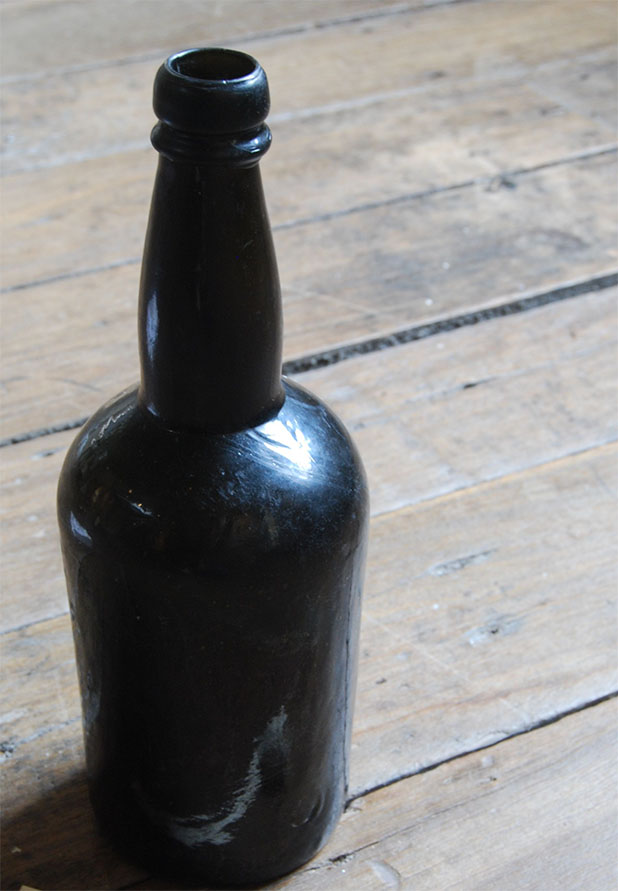

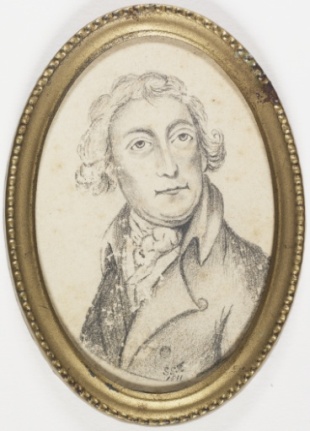
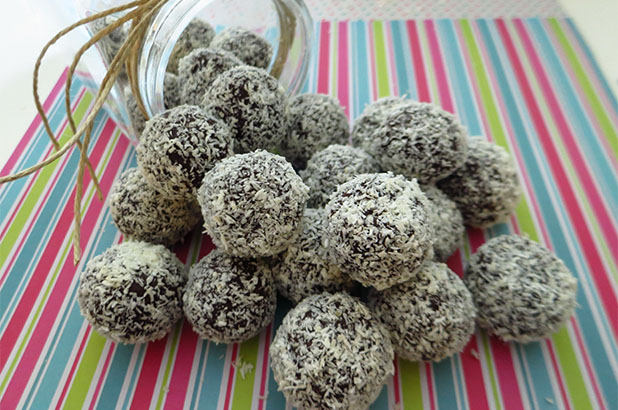
 Print recipe
Print recipe